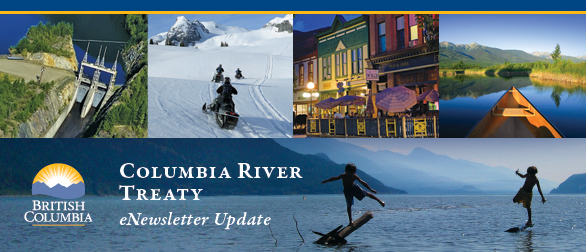Columbia River Treaty
Edition:

Treaty Review Question of the Month: December
Canadian Entitlement
What is the Canadian Entitlement?
Under Article V of the Columbia River Treaty, Canada is entitled to one half of the additional potential downstream power benefits, in energy and capacity, that can be generated in the United States as a result of the water flow management from British Columbia storage reservoirs. Canada’s portion of these downstream power benefits is called the Canadian Entitlement. In 1963, under the Canada- British Columbia Agreement, Canada transferred the benefits and obligations of the Treaty to the Province of British Columbia. In 1964 the Province pre-sold the first 30 years of the Canadian Entitlement for a lump sum of US$254 million. These funds were used to help finance the construction of the Columbia River Treaty dams. After the 30 year sale period expired, the benefits began to return to B.C. beginning in 1998, and reverted to full provincial control in April 2003.
How is the Canadian Entitlement Calculated?
The Canadian Entitlement is a calculated amount; it is not based on the actual operation of the entire hydropower system. The Treaty specifies how Mica, Arrow and Duncan dams (Canadian storage) will be operated to optimize flood control and power production in both countries. Based on these principles, an Assured Operating Plan, designed to achieve an optimum power operation in both Canada and the United States, is developed five years in advance. The Canadian Entitlement is calculated based on this potential optimum power operation.
How much is the Canadian Entitlement?
Under the Columbia River Treaty, the United States provides the Canadian Entitlement as energy and capacity, not money. Energy is the amount of electricity a generator produces over a specific period of time. For example, a generator with 1 MegaWatt (MW) capacity operating at that capacity consistently for one hour will produce 1 MW-hour (MWh) of electricity. If it operates at only half that capacity, 0.5 MW, for one hour, it will produce 0.5 MWh of electricity. Many generators do not operate at their full capacity all the time; they may vary their output according to power demand, conditions at the power plant, fuel costs, or as needed for electric power grid stability. Capacity is the maximum electric output a generator can produce under specific conditions.
The Canadian Entitlement is delivered to the Canada-United States border at rates up to the full capacity Entitlement based on day-ahead scheduling by BC Hydro’s subsidiary, Powerex, which markets the Entitlement on the Province’s behalf. The Entitlement is available at the border if required in B.C., or may be sold in markets in Alberta or the United States. The Province is compensated based on an arms-length index power price in the Pacific Northwest.
Since the full return of the Canadian Entitlement to B.C. in 2003, annual delivery has been at least 1,176 megawatts (MW) capacity and 4,073 gigawatt-hours (1 GWh = 1,000 MWh) of energy. Revenue from the sale of the Canadian Entitlement over the 10 years has been about $100-$300 million annually.
Why does revenue from the Canadian Entitlement fluctuate?
Revenue from the sale of Canadian Entitlement is dependent on the market price of electricity. The market price of electricity is affected by seasonal supply and demand, with natural gas fired power generation and wind power being the generation sources that currently strongly impact price. Because of a current abundant supply of natural gas in North America, natural gas prices are low causing low market prices for electricity. Significant development of wind power in the Pacific Northwest is also impacting wholesale power market prices. When the market prices for electricity are low, the revenue from the sale of the Canadian Entitlement will be lower resulting in less revenue to the Province.
Where does the Canadian Entitlement go?
The proceeds from the sale of the Canadian Entitlement go into the Province of B.C.’s Consolidated Revenue Fund. Revenue in the Consolidated Revenue Fund is used to fund provincial spending in areas such as healthcare, education, transportation infrastructure and environmental protection. Below is a table showing the amount of money received by B.C. over the last 10 years from the sale of the Canadian Entitlement:
Columbia River Treaty Canadian Entitlement Revenue to B.C.
2002/03 - $100 million
2003/04 - $230 million
2004/05 - $258 million
2005/06 - $319 million
2006/07 - $223 million
2007/08 - $246 million
2008/09 - $231 million
2009/10 - $168 million
2010/11 - $136 million
2011/12 - $110 million
Why do some parties in the United States want to reduce the Canadian Entitlement?
In the late 1980’s, United States (U.S.) hydropower system began to significantly alter operations in response to salmon protection directives under the U.S. Endangered Species Act. As a result, water released from B.C. storage reservoirs is not used to maximize power generation once it crosses the Canada-U.S. border but rather is ‘re-regulated’ to meet the U.S. Endangered Species Act directives, referred to as biological opinions, or bi-ops.
Some stakeholders in the U.S. believe that because the ‘re-regulation’ of water in the U.S. results in less than optimal power generation operations in downstream facilities, the Canadian Entitlement should no longer be calculated based on the optimal power operations as required under the Treaty, but rather calculated based on the reduced amount of power that is actually generated.
B.C. believes that coordinated water flows, made possible because of B.C. water storage facilities, provides a value to the U.S. whether it is used for salmon protection, power generation or other economic, social and environmental benefits. Other than power generation, these benefits are not captured in the calculation of the Canadian Entitlement but B.C. believes they should also be taken into account. B.C. is preparing an evaluation of the full range of benefits that the coordination of water flows, made possible by B.C. storage reservoirs, provides to the U.S.

